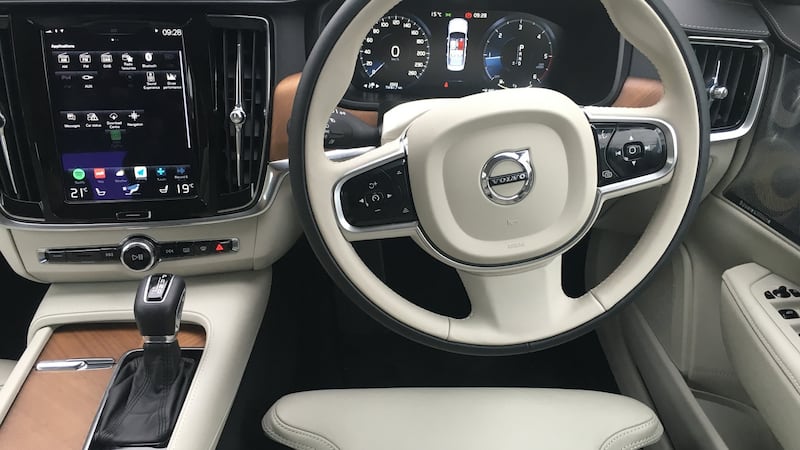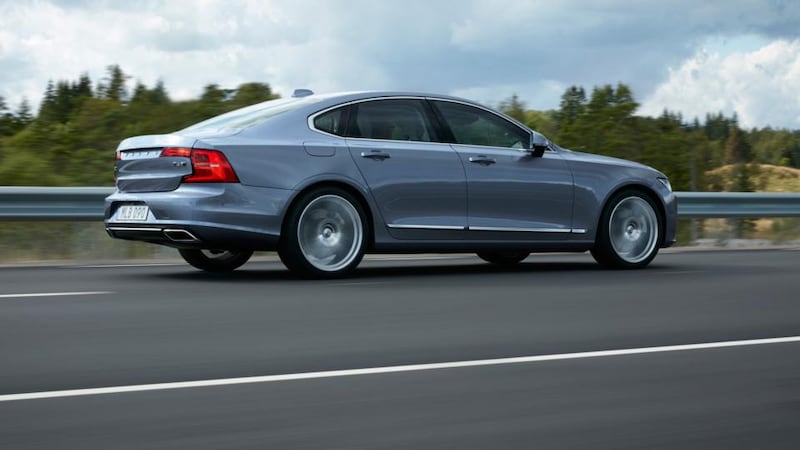Sometimes you can be too close to the trees to realise the extent of the forest. There’s a revolution under way in the motor industry and it’s not just about the advent of self-driving cars. The marriage of radar systems and camera technology is already bearing fruit, long before we get to the stage where you can take a nap in the driver’s seat during the morning commute.
As a motoring hack we bear witness to the revolution as weekly evolutions. It’s only when you have to talk someone through a new model like the Volvo S90 you realise how far we have come in the last five years.
The Volvo S90 is a major revolution for Volvo and not just in terms of tech. On looks alone it’s a bold and dramatic statement, throwing the gauntlet down to the Germans. In the space of 48 hours we were quizzed about the car seven times by passersby. At least three were driving German-built S90 rivals and in the market to change car. And in every case they were amazed at what’s come to market since they last bought a car.


Again, forget about any over-hyped self-driving features – something Volvo is at pains to play down given the system’s rudimentary ability at present. Volvo bills it as Pilot Assist. A standard on the S90, the car’s adaptive cruise control feature maintains the desired set vehicle speed but utilises radar to monitor the vehicle in front and automatically slows down or speeds up as necessary. That’s nothing new these days; adaptive cruise control has been with us for nearly 15 years now. However, in an evolution of this, Pilot Assist also takes care of the steering up to speeds of 130km/h by continually monitoring the area in front of the vehicle, making the necessary steering, accelerator and brake inputs as required to keep to the desired speed, distance and within the lane markings.
Easily confused
Self-driving? Afraid not. The system easily gets confused when road markings are unclear and with its constant adjustments to maintain road position it’s like being in the car with a drunk driver. Testing it in traffic proved disappointing as well as it leaves too large a gap with the car in front, inviting others to nip into the spot. In terms of self-driving cars, it makes you realise how far we have to go rather than how far we’ve come.
Yet that’s not to negate the tech revolution exemplified in the S90 – and it’s not just a fancy big touchscreen system in the central console.
The new S90 has city safety with autobrake. It has pedestrian, cyclist and large animal detection that automatically brakes if any of these wander into your path. It has a radar that detects if a rear impact is imminent. If so, it tightens the seatbelts to prepare for impact, while flashing the rear lights to alert the driver behind. It has lane-keeping assist. It has road sign recognition. It has run-off road protection, for those quiet rural roads where it detects if the car is at risk of leaving the road.
But what’s the car like otherwise? The design is stunning, a real statement of intent and a welcome kick in the pants of German rivals who stick to formulaic looks for their executive models.
Impressive legroom
This is a big car, similar in stature to the rival
BMW
5-Series, Audi A6 or
Mercedes-Benz
E-Class. However, it’s longer and wider than rivals and as such boasts impressive rear-seat legroom, certainly enough to tempt taxi drivers and chauffeurs to give the S90 a closer inspection.
One four-cylinder 2-litre diesel engine in two flavours is on offer for Irish buyers at the moment: the D4 190bhp and the D5 235bhp. The latter is the better engine variant, not only in terms of potency but also in refinement. The extra 45bhp is noticeable, as is the extra 80Nm of torque. On paper the 0-100km/h acceleration goes from 7.9 seconds on the D4 to 6.7 seconds on the D5. Both are mated to a smooth 8-speed automatic.
Our D4 test car was fitted with 20-inch alloys, a €2,500 extra on the D4. While they look great, they detract from the ride quality, are a nightmare in city car parks and not worth the outlay. If you don’t like the 17-inch alloys then spend €1,000 on the 18-inch alloys.
Ordering the 18-inch alloys allows you to opt for the rear electronic air suspension as well, though for a further outlay of €2,600. We’ve tested both the standard suspension and this system, and there is a very noticeable difference. Without air suspension the S90 sits on a more rudimental leaf spring suspension and on poorly surfaced roads the car’s ride is choppy and lacked refinement. It’s arguably the weakest link in the S90.
The D5 engine variant also boasts another smart innovation dubbed PowerPulse, spelling the end to diesel turbo lag.
Consider a situation on the motorway where you’re cruising along at low revs. Your engine isn’t creating much exhaust pressure so the turbo is spinning slowly. You need to overtake a line of traffic so you drop down a gear and accelerate hard. Normally the turbo needs to wait for the exhaust pressure to build up to get the necessary kick. Not any more. Basically, PowerPulse is a small, automatically refilled air canister that can force air through the turbo when you accelerate hard while it waits for the exhaust pressure to catch up.
It's the fruit of efforts by a high-flying powertrain engineer Michael Fleiss, who was lured from VW Group by Volvo. His previous role was director of engine engineering at Bentley.
Premium fit and finish
Another talent lured from Bentley was
Robin Page
, the luxury carmaker’s head of interior design. Page worked on the interiors of cars like the Bentley Continental. His CV also boasts brands like Rolls Royce and
Bugatti
. The first fruit of his labours at Volvo was the XC90 and that much-praised premium fit and finish carries forward into the S90.
Two grades are on offer: Momentum and Inscription. The latter is largely aesthetic. Prices start at €48,400 for the D4 Momentum. Inscription adds another €4,500 – money better spent on the options list.
Pricing is very competitive against comparable rivals. BMW’s 520d SE auto starts at €49,203 while a 190bhp Audi A6 S-Tronic auto SE is €48,800. The recently launched Mercedes E220d starts at €52,850. Jaguar’s new XF automatic starts at €48,995 for the 163bhp Prestige, while the Lexus GS starts at €49,950. Admittedly, the German rivals offer lower-powered and manual versions that are more competitively priced.
So does this Swede beat the Germans? It’s certainly a bolder statement than any of its rivals and ultimately on a par with any of its rivals. The ride quality on the regular suspension is perhaps its weakest feature, while the D4 engine note isn’t as refined as BMW’s 2-litre offering. The best S90 offering is the D5 all-wheel-drive Momentum at €56,200, with optional air suspension bringing the price close to €60,000, but that’s probably too rich for many budgets.
A new 5-Series is due to arrive for 2017 sales and some buyers will want to wait and see. However, while the Bavarian remains the driving benchmark in this class, the Volvo S90 is the boldest statement by far in the executive class and for many buyers that’s what matters most. It’s a touchpoint for the fast-paced tech revolution under way. More importantly, it’s a brilliant follow-on to the XC90 in what is an intriguing revolution at the Volvo brand. Suddenly the Germans are starting to sit up and take notice of what’s happening in Sweden.
Lowdown: Volvo S90 D4
Engine: 1969cc four-cylinder diesel engine with 190bhp @ 4,250rpm and 400Nm of torque from 1,750rpm
0-100km/h: 7.9 seconds
L/100km (mpg): 4.4 (64.2)
CO2 (Motor tax): 116g/km (€200)
Prices: Starting at €48,400 (€52,900 as tested)











